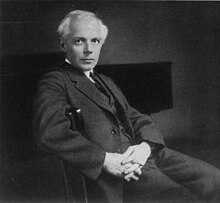Music for Strings, Percussion and Celesta
| Music for Strings, Percussion and Celesta | |
|---|---|
| byBéla Bartók | |
 The composer in 1927 | |
| Catalogue | Sz.106, BB 114 |
| Composed | 1936 |
| Dedication | Paul Sacher |
| Published | 1937 |
| Movements | Four |
| Premiere | |
| Date | January 21, 1937 |
| Location | Basel,Switzerland |
| Conductor | Paul Sacher |
| Performers | Basler Kammerorchester |
Music for Strings, Percussion and Celesta,Sz.106, BB 114 is one of the best-known compositions by the Hungarian composerBéla Bartók.Commissioned byPaul Sacherto celebrate the tenth anniversary of the chamber orchestraBasler Kammerorchester,the score is dated September 7, 1936.
The work was premiered inBasel,Switzerland,on January 21, 1937 by the chamber orchestra conducted by Sacher, and was published the same year byUniversal Edition.
Analysis[edit]
As its title indicates, the piece is written forstring instruments(violins,violas,cellos,double basses,andharp),percussion instruments(xylophone,snare drum,cymbals,tam-tam,bass drum,andtimpani) andcelesta.The ensemble also includes apiano,which, due to the hammer mechanisms inside, can also be considered a percussion instrument; the celesta player joins the pianist in some four-hands passages. Bartók divides the strings into two ensembles which, he directs, should be placedantiphonallyon opposite sides of the stage, and he makes use of antiphonal effects particularly in the second and fourth movements.
The piece is in four movements: the first and third slow; the second and fourth quick. All the movements are written without akey signature:
- Andante tranquillo
- Allegro
- Adagio
- Allegro molto

The first movement is a slowfuguewith a constantly changingtime signature.The movement is based around the note A, on which it begins and ends. It begins withmutedstrings, and as more voices enter, thetexturethickens and the music becomes louder, coming to a climax on E♭,atritoneaway from A. Mutes are then removed, and the music becomes gradually quieter over gentle celestaarpeggios.The movement ends with the second phrase of the fuguesubjectplayed softly over itsinversion.The first movement can be seen as a basis for material in the later movements; the fugue subject recurs in different guises throughout the piece.
The second movement is quick, with a theme in2
4time which is transformed into3
8time towards the end. It is marked with a loudsyncopatedpiano and percussion accents in a whirling dance, evolving in an extendedpizzicatosection, with a piano concerto-like conclusion.
The third movement is slow, an example of what is often called Bartók's"night music".It features timpaniglissandi,an unusual technique at the time of the work's composition, as well as a prominent xylophone part. The rhythm of the xylophone solo that opens the third movement is a "written-outaccelerando/ritardando"that follows theFibonacci sequence,the notated rhythm representing 1:1:2:3:5:8:5:3:2:1:1 notes per beat in sequence.
The fourth and final movement, which begins with notes on the timpani and strummed pizzicato chords on the strings, has the character of a lively folk dance.
Popular culture[edit]
The popularity ofMusic for Strings, Percussion and Celestais demonstrated by the use of themes from this work in films and popular music. The second movement accompanies "Craig's Dance of Despair and Disillusionment" in the filmBeing John Malkovich.The Adagio was used as the theme music forThe Vampira Show(1954–55). The movement was also featured in theEncyclopaedia BritannicafilmThe Solar System(1977) andStanley Kubrick's filmThe Shining(1980). Jerry Goldsmith wrote in the style of this piece for the 1962 filmFreud: The Secret Passion.It also was the soundtrack for the 1978 Australian filmMoney Movers.Anthony "Ant" Davisof thehip hopgroupAtmospheresamples the piece on the song "Aspiring Sociopath". The first movement is used inJoanna Hogg's 2022 filmThe Eternal Daughter.
The architectSteven Hollused the overlappingstrettosin this piece as a model for the form of the Stretto House (1989) in Dallas, Texas.
The novelCity of Night(1962) byJohn Rechymakes reference toMusic for Strings Percussion and Celesta,a work that haunts the main character. The piece is also mentioned inJohn Fowles's novelThe Collector;one of the main characters, Miranda Grey, calls it "The loveliest."
Much of the music from this collection, along withThe Miraculous Mandarin,can be heard as underscore for twoDoctor Whostories: 1967's "The Enemy of the World"and 1968's"The Web of Fear".
Discography[edit]
The first recording of the work was made in 1949 by the Los Angeles Chamber Symphony underHarold Byrns.[2]
Other recordings include:
- Herbert von Karajanand thePhilharmonia Orchestra(1949 – the second recording of the work)
- Ferenc Fricsayand theRIAS Symphony Orchestra(1954)
- Sir Adrian Boultand the Philharmonic Promenade Orchestra (~1955)
- Fritz Reinerand theChicago Symphony Orchestra(1958)
- Leopold Stokowskiand the Leopold Stokowski Orchestra (1959)
- György Leheland the Hungarian Radio Orchestra (1961)
- Leonard Bernsteinand theNew York Philharmonic(1961)
- Herbert von Karajanand theBerlin Philharmonic Orchestra(1961)
- Antal Dorátiand theLondon Symphony Orchestra
- Yevgeny Mravinskyand theLeningrad Philharmonic Orchestra(1965 & 1967 {live})
- Pierre Boulezand theBBC Symphony Orchestra(1967)
- Neville Marrinerand theAcademy of St Martin in the Fields(1970)
- Herbert von Karajanand theBerlin Philharmonic Orchestra(1973)
- Antal Doratiand thePhilharmonia Hungarica(1974)
- Mariss Jansonsand theOslo Philharmonic Orchestra
- Eugene Ormandyand thePhiladelphia Orchestra(1979)
- Moshe Atzmonand theTokyo Metropolitan Symphony Orchestra(1981)
- Charles Dutoitand theMontreal Symphony Orchestra(1987)
- Iván Fischerand theBudapest Festival Orchestra(1987)
- Georg Soltiand theChicago Symphony Orchestra(1989–90)
- Pierre Boulezand theChicago Symphony Orchestra(1994)
- Esa-Pekka Salonenand theLos Angeles Philharmonic(1996)
- Jukka-Pekka Sarasteand theToronto Symphony Orchestra(1997)
References[edit]
- ^Michiel Schuijer (2008-11-30).Analyzing Atonal Music: Pitch-Class Set Theory and Its Contexts.University Rochester Press. p. 79.ISBN978-1-58046-270-9.
- ^"Central Opera Service Bulletin"(PDF).Winter 1977–78.Retrieved2010-07-17.
External links[edit]
- Music for Strings, Percussion, and Celesta:Scores at theInternational Music Score Library Project
- Chapter 7of Larry Solomon'sSymmetry as a Compositional Determinant(an analysis of some formal aspects of the piece)
